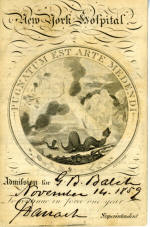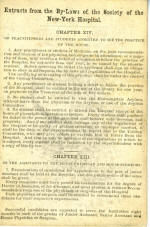New York Hospital
Click image to enlarge
New York Hospital was the oldest hospital in New York City and the second oldest hospital in the United States, second only to Pennsylvania Hospital in Philadelphia, which was founded in 1751. The history of New York Hospital is intimately related to the history of New York City. At the first graduation exercises of the medical school of King's College, held in Trinity Church in 1769, Dr. Samuel Bard, Professor of the Practice of Medicine, established the need for a "Public Hospital for the Reception of the Poor Sick of this Government and City." He stressed the triple missions of patient care, research, and teaching which such an institution should fulfill. Within a day, the Governor of the Province, Sir Henry Moore, started a fund; and in 1771, King George III of England granted a royal charter to establish "The Society of the New York Hospital in the City of New York in America" and a Board of Governors. The initiative for forming a hospital came from a growing medical community that included Dr. Bard, as well as Drs. Peter Middleton and John Jones. The financial and moral support came from the outstanding citizens of the community who were largely merchants. The small hospital was erected on a plot of land along the west side of Broadway between what is presently Worth Street and Duane Streets. It was set back about 90 feet from Broadway, allowing considerable space on all sides for lawn and future buildings.
A serious fire and the Revolutionary War delayed the opening of the Hospital until 1791, just in time to administer to patients during the yellow fever epidemic. In the interim, the building was used as barracks for Hessian and British soldiers, as a laboratory for teaching anatomy to medical students, and as a military hospital. The state legislature met there on two occasions. The area was so secluded that it became a favorite place for duels. Even in those days, there was almost constant need to renovate, expand, and modernize. The small two-storied, H-shaped building soon expanded to three stories; later, new buildings were built on the north and south sides. Gas illumination came in 1838 and steam heat in 1844.
Medical care was the best available for the time. It included surgery, medications, bloodletting, and purging. The physicians were trained in Europe or at one of the medical schools in New York City. The most distinguished of the early surgeons was Dr. Valentine Mott, a pioneer in vascular surgery. Among the physicians, Dr. David Hosack was outstanding. Both Aaron Burr and Alexander Hamilton were his patients. Attending Surgeon Dr. Valentine Seaman brought a vaccination against smallpox to New York Hospital in 1799, only one year after Jenner published his first successful experiments. New York Hospital's pharmacopoeia was published in 1816, four years before the publication of the United States Pharmacopoeia. This caused considerable concern among the attending physicians about the potential abridgement of the physician's right to prescribe.
Staff
Throughout the years, New York Hospital and Cornell University Medical College were fortunate to have dedicated and distinguished doctors on staff. In addition to those already named, other surgeons were Drs. Willard Parker, Thaddeus M. Halsted, Robert F. Weir, Lewis Atterbury Stimson, George J. Heuer, and Frank Glenn. Noted physicians included Drs. Lewis A. Conner, Russell Cecil, Henricus J. Stander, Walter Niles, Oscar Schloss, Eugene DuBois, Connie M. Guion, and David P. Barr. Dr. William S. Halsted, of Johns Hopkins fame, served a brief period as junior physician.
Above history was revised and adapted from "History of the New York Hospital-Cornell Medical Center," an article by Ralph Engle, Jr., M.D., that first appeared in the medical center's Directory of Alumni and Staff, 1980.

